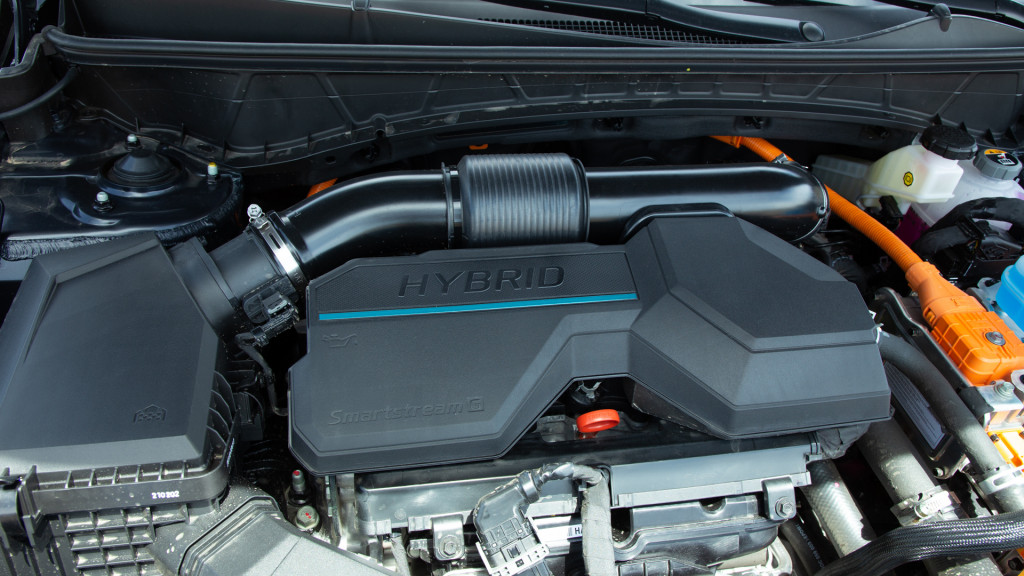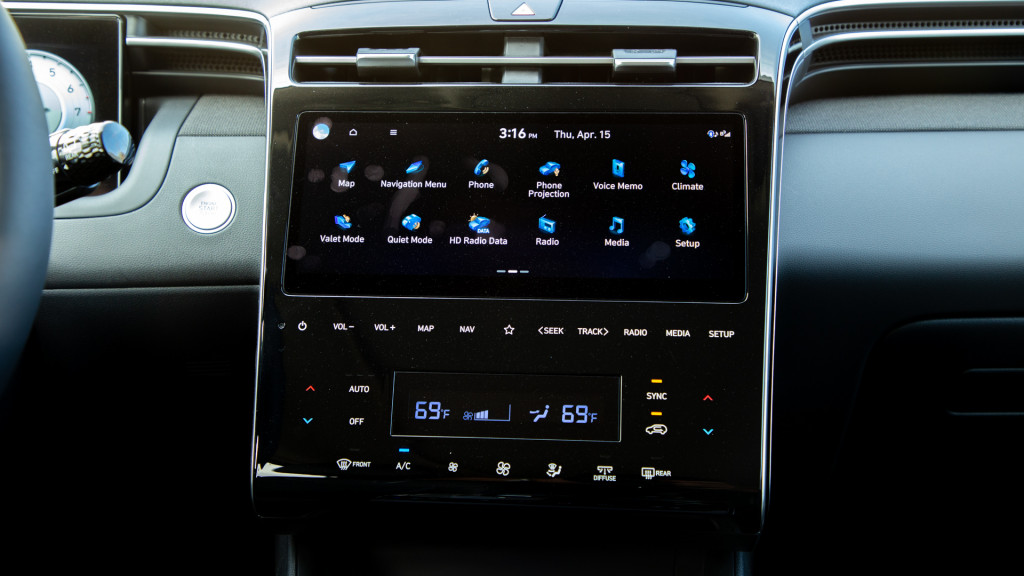First drive review: 2022 Hyundai Tucson Hybrid superiority extends beyond gas mileage
The 38-mpg Tucson Hybrid is the first hybrid SUV in Hyundai’s lineup, and from what I’ve seen it’s the best way you can get the new Tucson—for now.
The redesigned 2022 Tucson gets a fresh look, upgraded tech, and a growth spurt that gives it one of the best back seats in this crowded class. A relatively short drive on- and off-road was enough to reveal a fundamental truth about the Tucson Hybrid: it’s just better than its gas counterpart, full stop. Better on power, better on efficiency, and better even on driving dynamics thanks to a new e-handling system.
Hyundai introduced the new Tucson in, where else, Tucson, Arizona, but thankfully before the summer heat fully arrived. This is the same city where Honda introduced the CR-V Hybrid about a year ago and similar to that test, I got little highway time over the course of my morning with the Tucson Hybrid, before spending the afternoon in the gas version. The drive was about 50 miles of city streets and some 45-55 mph roads, but only a short stint on a road with a true highway speed limit. After that, it was 26 miles off off-road driving on a rough dirt and gravel road that left my brain a bit rattled and the Tucson Hybrid very dusty (as you can see from the photos).

2022 Hyundai Tucson
The Tucson Hybrid’s 1.6-liter turbo-4 engine (180 horsepower, 195 pound-feet of torque) is more powerful than the gas version’s 2.5-liter inline 4 (187-hp, 178 lb-ft) by itself. Tack on the output from the electric motor and that puts total system hp at a much more robust 226. The Tucson Hybrid uses a conventional for a 6-speed automatic transmission and all-wheel drive is standard. The electric motor is mounted before the prop shaft, not on the rear axle like it is in some hybrids, and the all-wheel-drive system fundamentally works the same as it does in the gas models with brake based torque vectoring at the rear.
Though we praised the CR-V Hybrid for providing a more EV-like experience, the Tucson Hybrid doesn’t offer that kind of drive. There are no paddle shifters to change the amount of braking regeneration, or an EV drive mode that you can select into. This is old-school hybrid stuff and the Tucson Hybrid simply asks the driver to stand back and let it do its work.
The electric motor does provide some helpful off-the-line burst and passing power was noticeably better in the Hybrid as well. I found the gas model to be a bit sluggish, but the Hybrid feels much more lively at any speed.
The e-handling system also gave the Tucson Hybrid an advantage on windier roads as well. The electric motor system applies slight braking on turn-in to increase traction and steering responsiveness, while on corner exits the system applies torque to the rear axle to push the Tucson Hybrid out of the turn and on its way. This system is unintrusive, it’s really only noticeable if you test the two vehicles in quick succession. It does make the Tucson Hybrid feel more balanced overall, though the lightness of the steering and noticeable body roll still remind you that this is a family vehicle first.

2022 Hyundai Tucson

2022 Hyundai Tucson

2022 Hyundai Tucson
The Tucson Hybrid’s EPA estimated fuel economy ratings are similar to those found in the CR-V Hybrid (38 combined mpg) and trail the RAV4 Hybrid slightly (40 combined mpg). The Blue models offer 38 mpg city, 38 highway, 38 combined, while the SEL Convenience/Limited trims come in slightly behind that at 37/36/37 mpg. All-wheel drive gas versions of the Tucson only offer 24/29/26 mpg, giving the Tucson Hybrid a 40% advantage in combined mpg.
Over the course of my drive, I ended up with 29.8 mpg, well short of the EPA rating but not bad considering the last one-third of the drive was off-road. We’ll have to wait for a longer road test to provide real-world fuel economy numbers.
I was also enamored with the Tucson Hybrid’s pricing structure. It’s offered in Blue, SEL Convenience, and Limited trims—the first two building onto a gas model with an options package added on. Blue models start at $30,235, SEL Convenience at $32,835, and Limited at $38,535. Those prices represent a $1,150 premium for the Blue and SEL Convenience over their gas counterparts, and a $1,250 premium for the Limited.
Those are differences that could be recaptured in fuel savings in just a few years, depending on how miles you drive annually. And that doesn’t include the added enjoyment from driving a Tucson that actually likes to move from a stop.

2022 Hyundai Tucson

2022 Hyundai Tucson

2022 Hyundai Tucson
All the technology and interior improvements make the Tucson more appealing. It’s grown by about 6-inches overall and adds 3.1-inches of rear legroom, bumping it up to 41.3 inches. This makes the backseat cavernous, especially since it can now recline back far enough to be comfortable for a quick nap.
The standard 8.0-inch touchscreen comes along with wireless Apple CarPlay connectivity (Android Auto is there as well but requires a cord), with a larger 10.3-inch screen coming on Limited models. One caveat: the larger screen axes wireless Apple CarPlay for reasons that still aren’t quite clear, and we’ve asked. The cargo area has also grown considerably to 38.7 cubic feet, which makes it competitive with the rest of the class.
If the Tucson Hybrid isn’t quite green enough, there’s a Tucson Plug-In Hybrid slated to head to dealerships this summer (the Tucson Hybrid goes on sale this Spring). Our hope is that the PHEV provides something closer to a true electric vehicle experience, like the RAV4 Prime does, even if it does have less range and power than its Toyota rival. But for those consumers looking for the best Tucson to buy in the immediate future, it’s the Hybrid. It makes me question why the gas version was needed at all.
Hyundai provided two kinds of Tucsons and lodging for Green Car Reports to bring you this firsthand test drive report.

